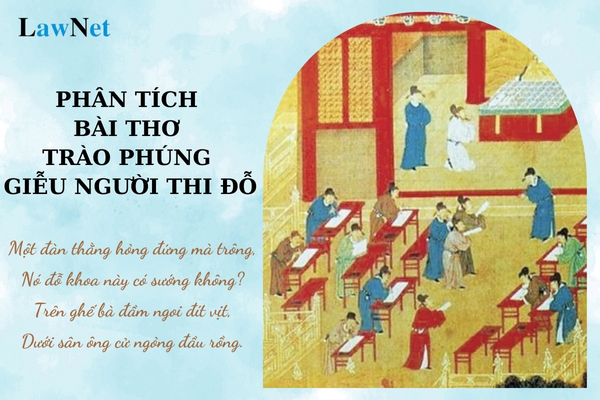What is the sample analysis essay on the satirical poem "Giễu người thi đỗ" by Tran Te Xuong for 8th-grade students in Vietnam? What is the organizational structure of lower secondary schools in Vietnam?
What is the sample analysis essay on the satirical poem "Giễu người thi đỗ" by Tran Te Xuong for 8th-grade students in Vietnam?
8th-grade students can refer to the following sample analysis essay on the satirical poem "Giễu người thi đỗ" by Tran Te Xuong:
Sample 1
|
The poem "Giễu người thi đỗ" by Tran Te Xuong is a work with profound satire, aiming to mock the superficial phenomena in the ancient feudal society. Through this, the author expresses his frustration with the deceit and insubstantial values in the society in which he lived. "On the chair, Madame rises like a duck" The image of Madame sitting on the chair with her posture like a duck and the scholar standing with a dragon's raised head is symbolic, humorous, yet very sharp. The image "Madame rises like a duck" is both humorous and a critique of the pretentiousness and ostentation of those with positions in society. They pretend to be noble, important, but are merely "ducks," unremarkable and undeserving of the fame they bear. Meanwhile, "the scholar raising a dragon head" is an exaggerated image representing the arrogant ones, regardless of whether they have considerable capabilities or not. |
Sample 2
|
In the feudal society, where fame and success were often tied to titles, exams were the only path to recognition and status. However, not everyone who achieved that title deserved it. Tran Te Xuong, one of the prominent figures of classical Vietnamese literature, used poetry to criticize and ridicule artificial phenomena, those who solely pursued fame and fortune without real capability. Through the poem "Giễu người thi đỗ," he skillfully reflects the phony face of society and the injustice in judging people. "On the chair, Madame rises like a duck" These images are not only humorous but also reflect arrogance and pretentiousness in feudal society. "Madame rises like a duck" is a humorous yet sarcastic image, critiquing those in power lacking actual qualities and talent. They try to flaunt and showcase authority, yet they are undeserving of the positions they hold. The image of "the scholar raising a dragon's head" is an exaggerated satire, symbolizing the arrogance of those who pass. They see themselves as "dragons," but in reality, they are merely boastful, lacking true capability. The contrast between the images of "Madame" and "the scholar" further highlights the pretentiousness and arrogance of those who achieved titles without noteworthy talent. |
Note: The content is for reference purposes only

What is the sample analysis essay on the satirical poem "Giễu người thi đỗ" by Tran Te Xuong for 8th-grade students in Vietnam? What is the organizational structure of lower secondary schools in Vietnam? (Image from the Internet)
What is the organizational structure of lower secondary schools in Vietnam?
Under Article 9 of the lower secondary school, upper secondary school and multi-level school charter issued along with Circular 32/2020/TT-BGDDT, the organizational structure of lower secondary schools in Vietnam includes:
- school council;
- principal and deputy principal(s);
- emulation and reward council;
- disciplinary councils;
- advisory councils;
- affiliate of the Communist Party of Vietnam;
- affiliate of trade union;
- affiliate of Ho Chi Minh Communist Youth Union;
- affiliate of Ho Chi Minh Young Pioneer Organization;
- specialized teams;
- office team;
- and units in charge of educational activities characteristic of the school.
Who does the student disciplinary council in a lower secondary school in Vietnam consist of?
According to clause 2, Article 12 of the lower secondary school, upper secondary school and multi-level school charter issued along with Circular 32/2020/TT-BGDDT:
Other councils in secondary schools
...
2. Disciplinary councils
a) The student disciplinary council shall be established to consider or lift disciplinary sanctions imposed upon students on a case-by-case basis. The principal has the power to issue decision on establishment of the student disciplinary council and lead this council. Members of the council include deputy principal(s), secretary of the Ho Chi Minh Communist Youth Union (if any), leader of the Ho Chi Minh Young Pioneer Organization (if any), homeroom teacher of the misbehaving student’s class, some teachers with experience in correcting misbehaving students and head of the parent committee of the school.
Thus, the student disciplinary council in a lower secondary school in Vietnam consists of:
- deputy principal(s),
- secretary of the Ho Chi Minh Communist Youth Union (if any),
- leader of the Ho Chi Minh Young Pioneer Organization (if any),
- homeroom teacher of the misbehaving student’s class,
- some teachers with experience in correcting misbehaving students and head of the parent committee of the school

